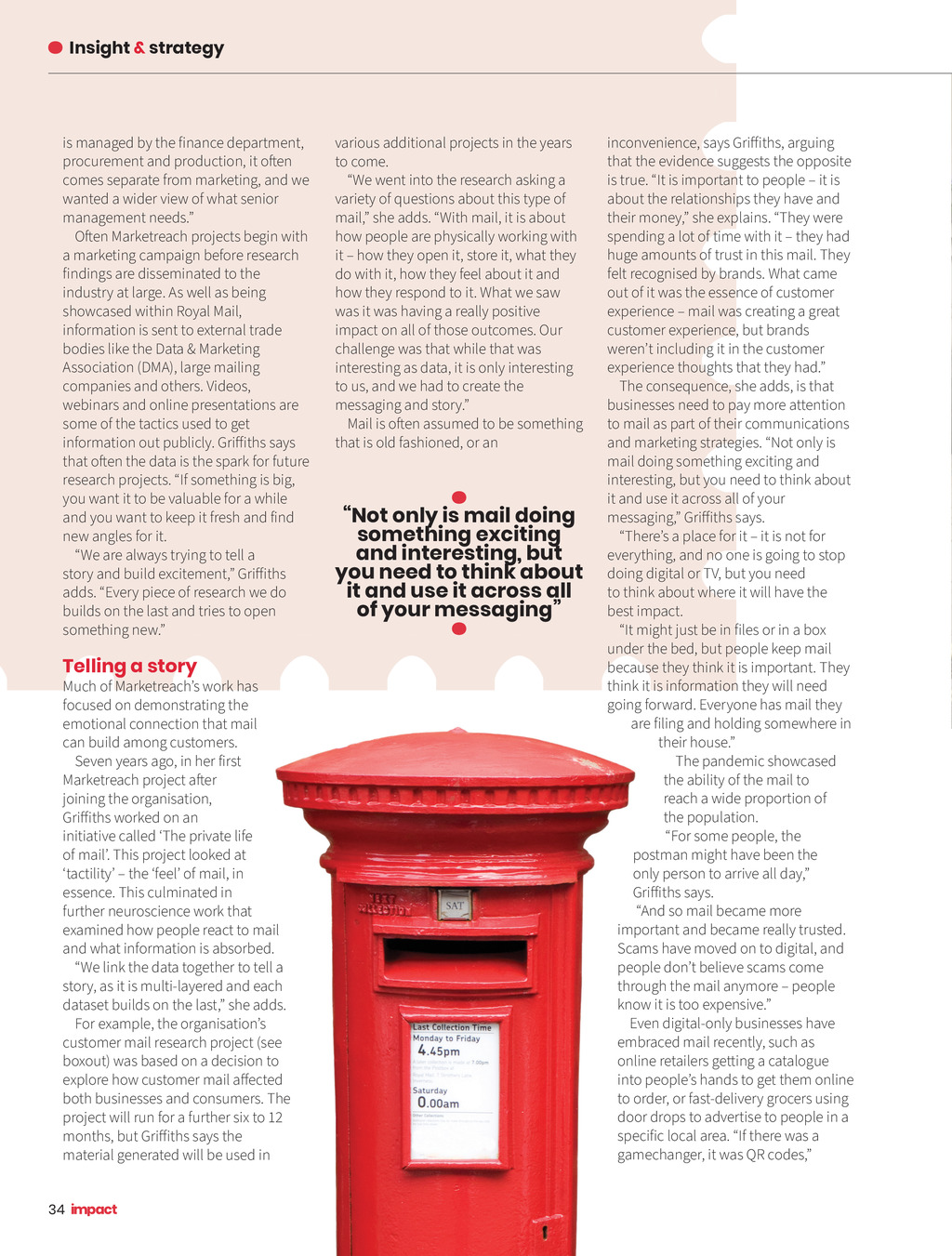




Insight & strategy is managed by the finance department, procurement and production, it often comes separate from marketing, and we wanted a wider view of what senior management needs. Often Marketreach projects begin with a marketing campaign before research findings are disseminated to the industry at large. As well as being showcased within Royal Mail, information is sent to external trade bodies like the Data & Marketing Association (DMA), large mailing companies and others. Videos, webinars and online presentations are some of the tactics used to get information out publicly. Griffiths says that often the data is the spark for future research projects. If something is big, you want it to be valuable for a while and you want to keep it fresh and find new angles for it. We are always trying to tell a story and build excitement, Griffiths adds. Every piece of research we do builds on the last and tries to open something new. Telling a story Much of Marketreachs work has focused on demonstrating the emotional connection that mail can build among customers. Seven years ago, in her first Marketreach project after joining the organisation, Griffiths worked on an initiative called The private life of mail. This project looked at tactility the feel of mail, in essence. This culminated in further neuroscience work that examined how people react to mail and what information is absorbed. We link the data together to tell a story, as it is multi-layered and each dataset builds on the last, she adds. For example, the organisations customer mail research project (see boxout) was based on a decision to explore how customer mail affected both businesses and consumers. The project will run for a further six to 12 months, but Griffiths says the material generated will be used in various additional projects in the years to come. We went into the research asking a variety of questions about this type of mail, she adds. With mail, it is about how people are physically working with it how they open it, store it, what they do with it, how they feel about it and how they respond to it. What we saw was it was having a really positive impact on all of those outcomes. Our challenge was that while that was interesting as data, it is only interesting to us, and we had to create the messaging and story. Mail is often assumed to be something that is old fashioned, or an Not only is mail doing something exciting and interesting, but you need to think about it and use it across all of your messaging inconvenience, says Griffiths, arguing that the evidence suggests the opposite is true. It is important to people it is about the relationships they have and their money, she explains. They were spending a lot of time with it they had huge amounts of trust in this mail. They felt recognised by brands. What came out of it was the essence of customer experience mail was creating a great customer experience, but brands werent including it in the customer experience thoughts that they had. The consequence, she adds, is that businesses need to pay more attention to mail as part of their communications and marketing strategies. Not only is mail doing something exciting and interesting, but you need to think about it and use it across all of your messaging, Griffiths says. Theres a place for it it is not for everything, and no one is going to stop doing digital or TV, but you need to think about where it will have the best impact. It might just be in files or in a box under the bed, but people keep mail because they think it is important. They think it is information they will need going forward. Everyone has mail they are filing and holding somewhere in their house. The pandemic showcased the ability of the mail to reach a wide proportion of the population. For some people, the postman might have been the only person to arrive all day, Griffiths says. And so mail became more important and became really trusted. Scams have moved on to digital, and people dont believe scams come through the mail anymore people know it is too expensive. Even digital-only businesses have embraced mail recently, such as online retailers getting a catalogue into peoples hands to get them online to order, or fast-delivery grocers using door drops to advertise to people in a specific local area. If there was a gamechanger, it was QR codes, 34 Impact ISSUE 39 2022_pp32-35 I&S Royal Mail.indd 34 23/09/2022 15:04